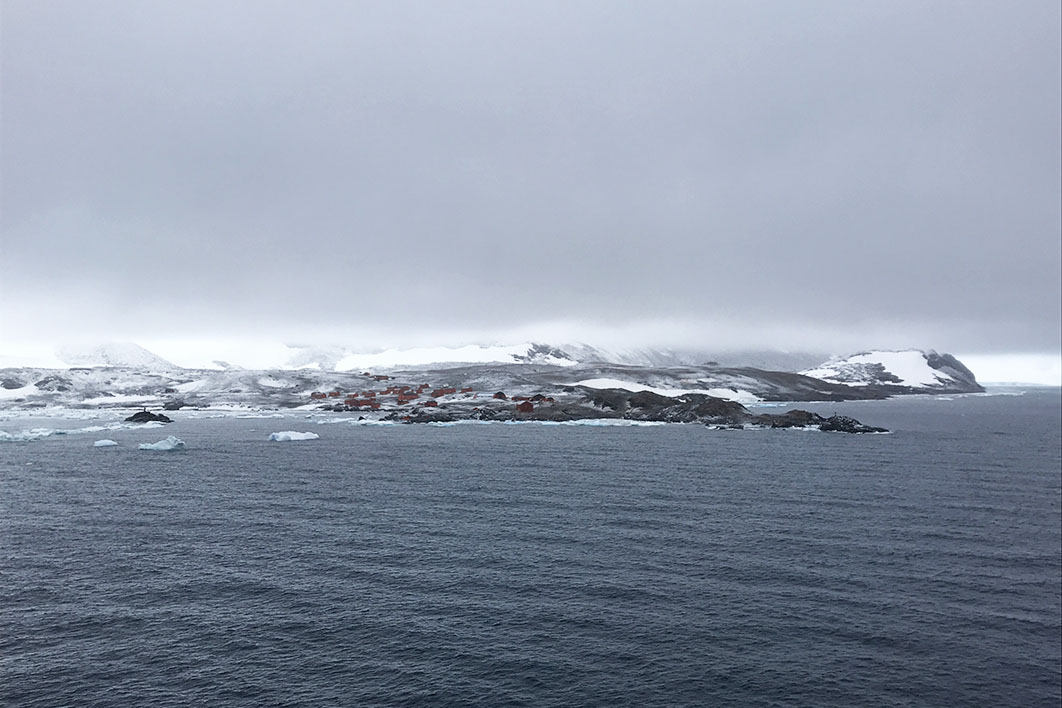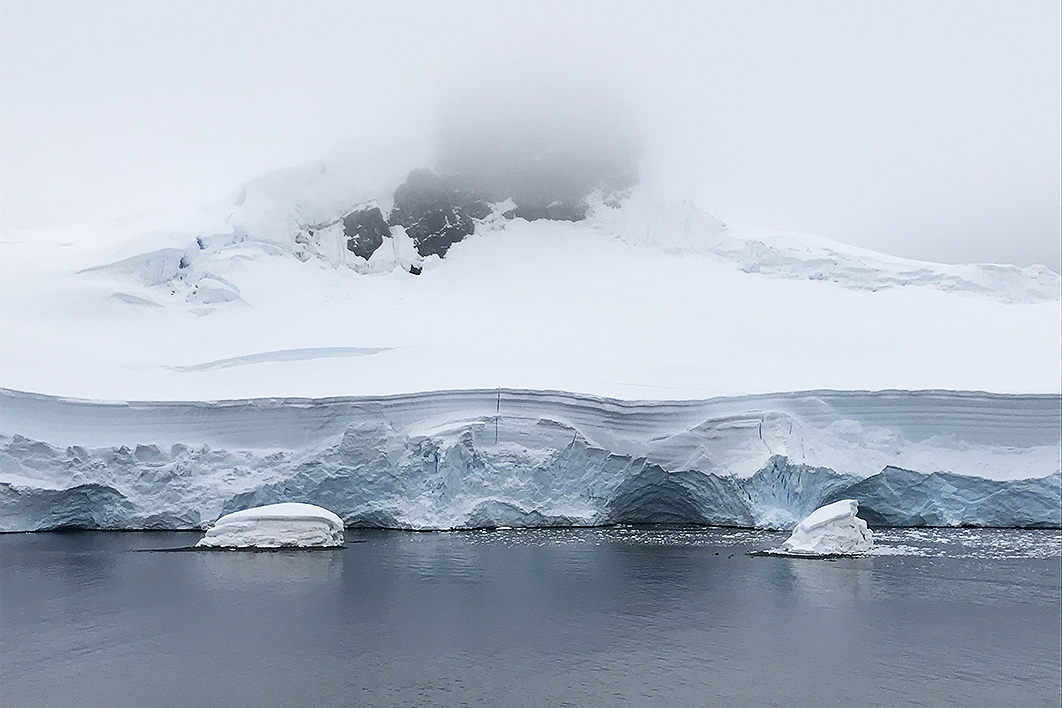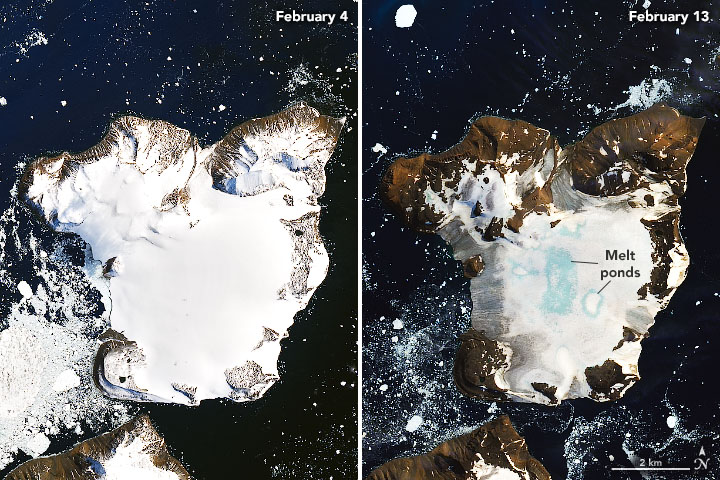Summer has been hot in Antarctica. On 6 February the Argentine Antarctic station Esperanza recorded a temperature of 18.3°C, the warmest conditions ever detected at that location. On the relatively balmy Antarctic Peninsula to the south of South America — some call it Antarctica’s banana belt — that record slightly eclipsed the previous one of 17.5°C in March 2015. Only three days later, to truly emphasise that we are living in rapidly warming times, a temperature of 20.75°C was recorded at the Brazilian Marambio Base on Seymour Island, also at the northern tip of the peninsula.
I happened to have been travelling in that very area only a week earlier. Our tourist ship had entered Hope Bay, where Esperanza station sits, on the morning of 29 January. Dark grey clouds were hanging low over the glaciers and mountains around the bay, and the water was open but for a few bergy lumps. Although the cloud obscured the warming sun, we had a good view over the Adélie and gentoo penguin rookeries that surround the small village of red buildings. Here, human and penguin colonies cluster close together.
Hope Bay is perhaps fated to be an Antarctic hotspot. On 1 February 1952 it was the site of the only armed encounter in Antarctic history, part of the decades-long territorial contest between Britain and Argentina. When a party of British scientists had begun re-establishing a base there, the encamped Argentine naval personnel tried to ward them off, first with a small burst of machine-gun fire and then with rifles, at which point the British took to their ship. Interestingly, the onboard historian for our cruise, a very experienced British Antarctic hand who had himself been an unwilling guest of the invading Argentines on South Georgia in 1982, neglected to mention this interesting piece of human history in his commentary from the bridge.

Shades of grey: approaching Esperanza Base on 29 January. Alessandro Antonello
The day before our brief visit to Hope Bay another Antarctic hotspot was in the news. Scientists working at Thwaites Glacier — an outlet glacier of the West Antarctic Ice Sheet — released the first-ever footage of its “grounding line,” the place where glacial ice meets continental rock. These lines, below sea level, are highly sensitive to increasing water temperatures, making them the sheet’s weak points. Were it to fully melt, the West Antarctic Ice Sheet would add three to six metres to the global sea-level, so a great deal of research effort is going into understanding its dynamics.
The media, perhaps unhelpfully, calls this the doomsday glacier. At higher latitudes, the satellite internet on the ship was slowing considerably, so it was a little difficult for us to view the footage from Thwaites Glacier clearly. Having studied the history of glaciology, including the historical efforts to understand the unstable West Antarctic Ice Sheet, I knew the importance of the moment. Since the 1970s, glaciologists and geophysicists have known that a marine-grounded ice sheet like this one would be vulnerable to rising temperatures. With the summer just finishing, we must now wait for the scientists to evaluate their data and present their analyses.
The ship I was on crossed sixty degrees south — the northern boundary of the Antarctic Treaty area — at about seven in the morning on 27 January. We were welcomed by a blanket of fog and a calm sea; our field of vision was defined by a spectrum of greys, blacks and whites. It was an auspicious day to enter the Antarctic, 200 years after Russian navigator Faddei Faddeyevich Bellingshausen made the first recorded sighting of the Antarctic continent. Aboard the Vostok — joined by the Mirny under the command of Mikhail Petrovich Lazarev — Bellingshausen saw what is now the Crown Princess Martha Coast in Queen Maud Land, part of the territory claimed by Norway. Poor Edward Bransfield, a British naval officer who saw the Trinity Peninsula on 30 January 1820, missed out on being first by only a few days.
Two hundred years after Bellingshausen, Russia is pushing on with its Antarctic efforts. On 12 February, the Russian state geological survey agency, Rosgeologia, announced it had spent the beginning of 2020 exploring the Antarctic continental shelf for oil and gas. In the Riiser-Larsen Sea — a few degrees to the east of the coastline Bellingshausen saw — it found what it describes as “potential hydrocarbon resources… estimated at about seventy billion tons.”
For those concerned about global carbon emissions and also environmental protection in Antarctica, this is worrying news. Mineral exploitation in Antarctica is banned under the 1991 Madrid Protocol to the Antarctic Treaty. Any suggestion, let alone an outright confirmation, that it will happen raises the geopolitical heat within the Antarctic Treaty System.
Rosgeologia’s work this summer is part of a decades-long search for oil and gas in the Antarctic by countries working within the Antarctic Treaty of 1959. There were early hopes of a hydrocarbon cornucopia that might supply a world cursed by energy scarcity as a result of either the “population bomb” or an Arab oil embargo. In 1969, oil was placed firmly on the Antarctic Treaty agenda when several companies began asking for exploration licences.
Soon it was the United States that seemed most eager and most capable of drilling for oil in Antarctica. Production was expanding into the Alaskan Arctic, so the challenges of a polar environment seemed technically surmountable; even the offshore drilling in the Gulf of Mexico and the North Sea, with their tempests, seemed to suggest that overcoming environmental barriers was merely a matter of technology and time. Throughout the 1970s, US diplomats, pushed and pulled by oil and energy interests at home, obstructed attempts by other countries within the Antarctic Treaty to restrain oil exploration and exploitation.
Even scientific drilling hasn’t been immune from suspicion. Drilling for ice cores (notably including the one extracted at the Soviet Union’s Vostok station in the 1970s and 1980s) has transformed our knowledge of climate change by demonstrating the link between carbon dioxide levels and global temperatures, but some geophysical research has inadvertently touched upon oil and gas.
When the research ship Glomar Challenger went to Antarctica in the summer of 1972–73, its drill penetrated gas deposits. As the Australian geoscientist Elizabeth Truswell details in her recent book about that voyage, A Memory of Ice, she and the other scientists on board were trying to understand the Antarctic ice sheet’s history. They pushed its known age back from three million years to at least twenty-five million years (a few more million years have since been added) but had to stop drilling when they hit gas, because of the danger to their vessel. The world’s media interpreted their results as another sign of Antarctica’s potential oil and gas wealth.

Warming times: Wilhelmina Bay on the Antarctic Peninsula. Alessandro Antonello
In the end, no commercial oil and gas drilling has ever taken place in Antarctica. Yet there have been vivid examples of the environmental dangers associated with it. The most significant oil spill came from the Argentine ship Bahia Paraiso, which ran aground in the Antarctic Peninsula in January 1989, spilling about 600,000 litres of oil. That incident, along with the catastrophic Exxon Valdez spill in Alaskan waters only two months later, highlighted the dangers of oil exploitation and transport. They contributed to the Antarctic Treaty parties’ agreeing to ban mining indefinitely in their 1991 Madrid Protocol, a deal that was hastily negotiated in place of a convention signed in 1988 that would have allowed mining.
News of Russia’s exploring for oil and gas in Antarctica is therefore not unprecedented. In the short term, the concern is less that Russia will begin full commercial operations in the Southern Ocean (a highly unlikely proposition) and more that it didn’t bother to disguise its efforts under the generic label of “scientific research.” Is this just another part of Putin’s global mischief-making? Russia also announced that it would send the world’s only nuclear-powered cargo ship, Sevmorput, south next summer with building supplies for Vostok station. Is that visit — apparently the first by a nuclear-powered vessel to Antarctica — part of a larger plan to raise the geopolitical heat?
The Bellingshausen anniversary has been a good opportunity for Russia to weave historic discovery and legitimation through its Antarctic activities. The Russian foreign minister, Sergei Lavrov, dutifully marked the anniversary and intriguingly, in an official recorded interview, stressed how Russian ambassadors and consuls around the world were essential to Bellingshausen’s success. Science, he was saying, did not happen without the state.
The Russian government has often used Bellingshausen’s achievement to justify its presence in Antarctica. In 1948, when the United States tried to pursue a solution to “the Antarctic problem” — the territorial conflict between Britain, Argentina and Chile and the contested territorial claims of Australia, France, New Zealand and Norway — the Soviet Union, newly armed with nuclear weapons and willing to contest American hegemony anywhere in the world, adduced the one example of historical connection to the Antarctic it had.
Lavrov wasn’t the only significant government figure to mark the Bellingshausen anniversary. The president of Estonia made an official visit to the Antarctic Peninsula aboard a small yacht. Bellingshausen, having been born in Riga to an Estonian-German family, has recently been somewhat reclaimed by Estonia as part of its post-Soviet identity. Estonia is making a name for itself as a “digital nation,” and so the president used her digital signature to conduct the business of state while she was observing the ravages of climate change. This seductive vision of non-territorial digital citizens roaming the globe, free to live their lives and do their work wherever they please, quickly butts up against the reality that the infrastructure of travel and computing blast out emissions that are helping to undermine Antarctica’s stability.
The summer also began with another big anniversary. Sixty years ago, on 1 December 1959, twelve nations signed the Antarctic Treaty in Washington, DC. The treaty was initially intended to guarantee freedom of scientific research and defuse territorial conflict in the region. Over its sixty years, it has been significantly enlarged and is now forcefully directed towards environmental protection and management. From twelve signatory nations there are now fifty-four parties, of whom twenty-nine are known as “consultative parties” — states with a right to participate in decision-making meetings for the continent.
“I believe no one wants to undermine the treaty,” Lavrov declared during the interview in January. “There are no signs of putting the treaty at risk.” Fine words indeed, but Russia’s actions in recent years can hardly be described as advancing the cause of environmental protection that is now so central to Antarctica’s governance. In addition to this summer’s search for fossil fuels, Russia has been obstructing action to conserve marine systems and fisheries in the Southern Ocean. In a working paper submitted to the 2019 Antarctic Treaty Consultative Meeting, it referred to “the ‘postponed’ use of mineral resources of the region.”
Russia isn’t the only country that still sees Antarctica as a potential site for drilling and mining. China clearly regards both the Antarctic and Arctic as resource frontiers where it will manifest its status as a “great polar power.” And several new or prospective Antarctic Treaty parties have also explicitly mentioned oil and mineral resources as part of their reasons for being in Antarctica and seeking “consultative” status within the treaty system.
Many Antarctic commentators are judging the treaty in terms of its ability to contain urges of this kind and the larger geopolitical manoeuvring they reflect. If this dreadful baking summer suggests anything, perhaps it’s that the need for broader global decarbonisation — rapidly, at that — will continue to undercut any justification for oil and gas exploration. While some countries will intermittently explore for oil and gas in Antarctica —openly or discreetly — the profound difficulties and expense of operating in Antarctic waters should prevent any serious exploitation. If a major oil company can’t see a future for drilling in the Great Australian Bight, can we seriously expect another to commence operations in Antarctica?
Summer is coming to an end. The last scientific resupply ships and flights are making the journeys that enable the permanent human occupation of the continent. This is the last season for the thirty-one-year-old Australian icebreaker Aurora Australis; it left the continent for the last time on 23 February, having resupplied Davis station. Sarah Laverick’s recent book Through Ice and Fire narrates the history of this fine vessel and its exceptional contributions to knowledge of the continent and the Southern Ocean. The launch of its replacement, Nuyina — a beautiful word for the southern lights from the Palawa kani language of Tasmania — is slightly delayed but promises a great future for Australian science in the south.
The season’s last flight from Australia’s Wilkins aerodrome leaves in early March. It has not been a happy summer for the ice runway, which was shuttered for nine weeks because the temperatures were too high. This phenomenon, sure to remain a problem over coming years, is encouraging environmentally destructive behaviour elsewhere. Australia plans to build a paved concrete runway in the Vestfold Hills, which will affect a significant patch of ice-free area and its delicate ecosystem. Although the plan is still undergoing environmental impact assessments — Antarctica is the one continent in which nearly all activities are carefully evaluated in this way — it does seem a foregone conclusion that the runway will be built.
While most tourist vessels have completed their season around the Antarctic Peninsula, some will ply the waters until late March. Warming in the peninsula is reducing sea ice and allowing the tourist season to operate over many months. In the parlance of the industry, what happens in Antarctica is “expedition cruising” and the tourists are thus “explorers.” This summer the explorers numbered more than 78,000, well up on last year’s figure of just over 56,000. These visits are not evenly spread across the region, with a few dozen sites bearing the brunt. New ships designed for polar tourism are being launched over coming seasons, so that number will only increase.
The hotspots we see in Antarctica — whether atmospheric or geopolitical — are related, though they have led to different kinds of responses. Those who look south through the lens of security see threats emerging from Antarctica. They see a platform for competition that we in Australia, or the West more generally, should be occupying with greater intensity in order to suppress, or at least match, any geopolitical threat from Russia and China. I’m more inclined to see the greater threat as the threat to Antarctica. The stability of the ice sheet and the health of animal populations rely on humanity drastically curbing emissions, and perhaps even curbing our footprint in the south.
The Australian author Meredith Hooper travelled to Antarctica a handful of times in the late 1990s and early 2000s. She spent the 2001–02 summer at the American Palmer station, a small base in the Antarctic Peninsula principally dedicated to studying the marine environment. Having trailed the ornithologists studying the local penguin rookeries, she called that season “the ferocious summer.” At the turn of the millennium, decades of data and scientific effort was showing that global warming was a dire problem. As a historian looking south, the most disconcerting element of this summer’s heat is that it repeats and renews the heat of past summers. Affairs seem not shockingly new but shamefully repetitive. •




